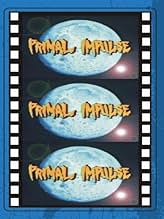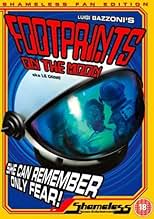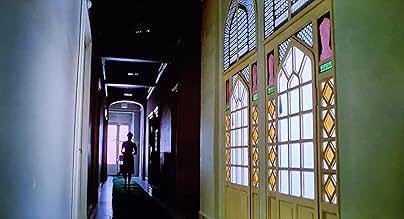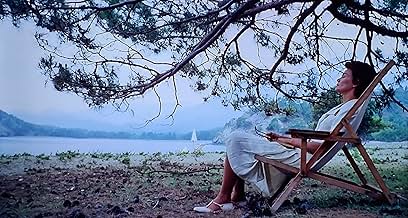IMDb-BEWERTUNG
6,6/10
2720
IHRE BEWERTUNG
Füge eine Handlung in deiner Sprache hinzuAfter being tormented by dreams about astronauts on the moon, a translator visits a deserted seaside town whose inhabitants know her, although she does not know them.After being tormented by dreams about astronauts on the moon, a translator visits a deserted seaside town whose inhabitants know her, although she does not know them.After being tormented by dreams about astronauts on the moon, a translator visits a deserted seaside town whose inhabitants know her, although she does not know them.
John Karlsen
- Alfredo Laurenti
- (as John Carlsen)
- …
Miriam Acevedo
- Alice's Supervisor
- (as Myriam Acevedo)
Rosita Torosh
- Marie Leblanche
- (as Rosita Toros)
Bruno Degni
- Member of the International Congress
- (Nicht genannt)
Franco Magno
- Member of the International Congress
- (Nicht genannt)
Lidia Zanussi
- Member of the International Congress
- (Nicht genannt)
Luciano Zanussi
- Member of the International Congress
- (Nicht genannt)
Feridun Çölgeçen
- Hotel Concierge
- (Nicht genannt)
Empfohlene Bewertungen
Unable to cope with mounting pressures at work and haunted by visions of a lone astronaut abandoned on the surface of the moon, Alice travels to the exotic sea side town of Garma to get away from it all.
She encounters a number of people there who claim to know her from earlier as Nicole, even though she insists this is her first time there. Brazillian born Florinda Bolkan turns in a solid performance as the elusive Portugese translator caught in the grips of a fugue.
A strange but oddly compelling existential mystery about dual identities and self-fulfilling prophecies, Footprints on the moon is more reminiscent of art-house favorites such as Antonioni's L'aventura and Passenger and Resnais' Last Year at Marienbad, than say other Mystery/Thriller Genre fare so popular at the time in Italy.
The story unfolds at a languorous pace and things get redundant after a while, but it does allow Cinematographer extraordinaire Vittorio Storaro to really explore the unique locations and dazzle with his wonderfully dexterous camera-work. He furthers the style he pioneered in The Conformist.
Also, watch out for Klaus Kinski in a small role as a sinister Space Commander on the lookout for guinea pigs to conduct his secret experiments for a shadowy Government agency. Yes, I'm talking about the same movie.
She encounters a number of people there who claim to know her from earlier as Nicole, even though she insists this is her first time there. Brazillian born Florinda Bolkan turns in a solid performance as the elusive Portugese translator caught in the grips of a fugue.
A strange but oddly compelling existential mystery about dual identities and self-fulfilling prophecies, Footprints on the moon is more reminiscent of art-house favorites such as Antonioni's L'aventura and Passenger and Resnais' Last Year at Marienbad, than say other Mystery/Thriller Genre fare so popular at the time in Italy.
The story unfolds at a languorous pace and things get redundant after a while, but it does allow Cinematographer extraordinaire Vittorio Storaro to really explore the unique locations and dazzle with his wonderfully dexterous camera-work. He furthers the style he pioneered in The Conformist.
Also, watch out for Klaus Kinski in a small role as a sinister Space Commander on the lookout for guinea pigs to conduct his secret experiments for a shadowy Government agency. Yes, I'm talking about the same movie.
I first heard of this one while searching the 'Net for reviews of another Italian giallo/horror effort, the contemporaneous THE PERFUME OF THE LADY IN BLACK (1974; whose R2 SE DVD from Raro Video, by the way, I recently acquired) where it's referenced as being in a similar vein but also just as good. Having watched FOOTSTEPS for myself now, I can see where that reviewer was coming from in that both films deal with the psychological meltdown of their female protagonist. Stylistically, however, this one owes far more to Art-house cinema than anything else in particular, the work of Alain Resnais and Michelangelo Antonioni (and, specifically, LAST YEAR IN MARIENBAD [1961] and THE PASSENGER [1975] respectively); accordingly, some have accused it of being "deadly boring" an epithet often attached to such 'pretentious' (read: cerebral) fare!
Anyway, the film involves the quest of a woman (Florinda Bolkan) to determine her movements in the preceding three days of which she seems to have no recollection. Following a series of cryptic clues, she travels to the 'mythical' land of Garma (nearby locations, then, bear the equally fictitious names of Muda and Rheember) where she encounters several people (including Lila Kedrova as an aristocratic regular of the resort) who ostensibly recall the heroine staying there during her 'blackout'! Most prominent, though, are a young man (Peter McEnery) and a little girl (Nicoletta Elmi, from Mario Bava's BARON BLOOD [1972]) the former always seems to happen on the scene at propitious moments, while the latter apparently confuses Bolkan with another woman (sporting long red hair and a mean streak!).
While essentially a mood piece, this is nonetheless a gripping puzzle: inevitably, vague events transpire at a deliberate pace and where much of the film's power derives from the remarkable central performance (which can be seen as an extension of Bolkan's role in the fine Lucio Fulci giallo A LIZARD IN A WOMAN'S SKIN [1971]). However, there's no denying the contribution of cinematographer Vittorio Storaro (who provides any number of sweeping camera moves and an effective color scheme adopting orange/red/blue filters to create atmosphere and coming up with a saturated look for the disorientating, bizarre finale) and Nicola Piovani's fitting melancholy score (the composer is best-known nowadays for his Oscar-winning work on Roberto Benigni's Holocaust-themed tragi-comedy LIFE IS BEAUTIFUL [1997]).
With this in mind, it's worth discussing how FOOTSTEPS was presented in the version I watched: well, being apparently hard-to-get in its original form (I can't be sure whether it's uncut here or not, except to say that the film ran for 89 minutes while the IMDb lists it at 96), this edition is culled from a fairly battered English-language VHS (the dubbing is surprisingly good, given the international cast) with burnt-in Swedish subtitles to boot (besides, the DivX copy froze for a few seconds at a crucial point in the story around the 82-minute mark)! Still, we do get a welcome bonus i.e. a 9-minute 'Highlights From The Soundtrack' in MP3 format.
I realize I haven't yet mentioned the moon mission subplot, to which Klaus Kinski's presence is restricted: incidentally, around this same time, he had a similarly brief but pivotal role in another good arty thriller with sci-fi leanings (and also set in a distinctive location) namely, LIFESPAN (1974). As I lay watching the film, I couldn't fathom what possible connection this had with the central plot except that Bolkan mentioned a recurring dream about a movie she had once seen, though not through to the end, called "Footsteps On The Moon" (a somewhat misleading alternate title for the film itself) amusingly, she at first recalls the picture as being called BLOOD ON THE MOON (which, of course, is a classic 1948 Western noir with Robert Mitchum and directed by Robert Wise!). That said, I took this 'diversion' in stride as merely one more outlandish touch to the film (given also Bolkan's former employment as a translator at a conference discussing Earth's future) and certainly didn't expect the astronauts to turn up on Garma's beach at the very end to pursue the female lead, where the sand then turns ominously into the moon's surface !
The film's plot will probably make more sense on a second viewing though, to be honest, this is best approached as a visual/aural experience and one shouldn't really expect it to deliver a narrative that's in any way clear-cut and easily rationalized! For the record, the only other Bazzoni effort I'd managed to catch prior to this one was the middling straight giallo THE FIFTH CORD (1971), starring Franco Nero (which I had recorded off late-night Italian TV); some time ago, I did get hold of his Spaghetti Western rendition of "Carmen" titled MAN, PRIDE AND VENGEANCE (1968) also with Nero and Kinski as a DivX (after I'd already missed a matinée broadcast of it) but the conversion had somehow proved faulty and, consequently, the disc wouldn't play properly!
Anyway, the film involves the quest of a woman (Florinda Bolkan) to determine her movements in the preceding three days of which she seems to have no recollection. Following a series of cryptic clues, she travels to the 'mythical' land of Garma (nearby locations, then, bear the equally fictitious names of Muda and Rheember) where she encounters several people (including Lila Kedrova as an aristocratic regular of the resort) who ostensibly recall the heroine staying there during her 'blackout'! Most prominent, though, are a young man (Peter McEnery) and a little girl (Nicoletta Elmi, from Mario Bava's BARON BLOOD [1972]) the former always seems to happen on the scene at propitious moments, while the latter apparently confuses Bolkan with another woman (sporting long red hair and a mean streak!).
While essentially a mood piece, this is nonetheless a gripping puzzle: inevitably, vague events transpire at a deliberate pace and where much of the film's power derives from the remarkable central performance (which can be seen as an extension of Bolkan's role in the fine Lucio Fulci giallo A LIZARD IN A WOMAN'S SKIN [1971]). However, there's no denying the contribution of cinematographer Vittorio Storaro (who provides any number of sweeping camera moves and an effective color scheme adopting orange/red/blue filters to create atmosphere and coming up with a saturated look for the disorientating, bizarre finale) and Nicola Piovani's fitting melancholy score (the composer is best-known nowadays for his Oscar-winning work on Roberto Benigni's Holocaust-themed tragi-comedy LIFE IS BEAUTIFUL [1997]).
With this in mind, it's worth discussing how FOOTSTEPS was presented in the version I watched: well, being apparently hard-to-get in its original form (I can't be sure whether it's uncut here or not, except to say that the film ran for 89 minutes while the IMDb lists it at 96), this edition is culled from a fairly battered English-language VHS (the dubbing is surprisingly good, given the international cast) with burnt-in Swedish subtitles to boot (besides, the DivX copy froze for a few seconds at a crucial point in the story around the 82-minute mark)! Still, we do get a welcome bonus i.e. a 9-minute 'Highlights From The Soundtrack' in MP3 format.
I realize I haven't yet mentioned the moon mission subplot, to which Klaus Kinski's presence is restricted: incidentally, around this same time, he had a similarly brief but pivotal role in another good arty thriller with sci-fi leanings (and also set in a distinctive location) namely, LIFESPAN (1974). As I lay watching the film, I couldn't fathom what possible connection this had with the central plot except that Bolkan mentioned a recurring dream about a movie she had once seen, though not through to the end, called "Footsteps On The Moon" (a somewhat misleading alternate title for the film itself) amusingly, she at first recalls the picture as being called BLOOD ON THE MOON (which, of course, is a classic 1948 Western noir with Robert Mitchum and directed by Robert Wise!). That said, I took this 'diversion' in stride as merely one more outlandish touch to the film (given also Bolkan's former employment as a translator at a conference discussing Earth's future) and certainly didn't expect the astronauts to turn up on Garma's beach at the very end to pursue the female lead, where the sand then turns ominously into the moon's surface !
The film's plot will probably make more sense on a second viewing though, to be honest, this is best approached as a visual/aural experience and one shouldn't really expect it to deliver a narrative that's in any way clear-cut and easily rationalized! For the record, the only other Bazzoni effort I'd managed to catch prior to this one was the middling straight giallo THE FIFTH CORD (1971), starring Franco Nero (which I had recorded off late-night Italian TV); some time ago, I did get hold of his Spaghetti Western rendition of "Carmen" titled MAN, PRIDE AND VENGEANCE (1968) also with Nero and Kinski as a DivX (after I'd already missed a matinée broadcast of it) but the conversion had somehow proved faulty and, consequently, the disc wouldn't play properly!
This is actually a very good surreal mystery movie, despite the description that tries to sell it as a Sci-Fi movie. Balkan stars as a woman haunted by mysterious visions and lost memories that she is trying to piece together. She spends the majority of the movie trying to make sense of her visions. Very atmospheric and effective. It is true that Kinski does not appear very much in this film, but the staring actors are very good. There is only an English dubbed version available in the US, and the dubbing leaves something to be desired, but the actors do a very good job. The cinematography, by Academy Award winner Vittorio Storaro is excellent. An earlier Giallo by director Bazzoni, THE FIFTH CORD, is also excellent, and also lensed by Storarro.
Footprints is a very interesting movie that is somewhat difficult to categorize. "Psychological thriller" is the most appropriate description I can think of. The female protagonist, Alice Cespi, discovers that she doesn't remember anything of the last three days. The only clue she has is a torn photo of a hotel. She is also haunted by a recurring, very vivid, dream about a science fiction movie that she believes she saw many years ago. In her pursuit of the truth behind her amnesia she doesn't trust anyone, but little by little it becomes obvious that she has visited the town where the hotel is located before. This is an exciting flick whose main virtue is that it is virtually impossible to predict how the events will unfold, and particularly, how it will end. The unusual loneliness of the main character and the unreliability of everyone else ensure that the good old paranoid feeling is present throughout the film, whereas beautiful colors and some spectacularly filmed sequences make this a visually attractive movie as well. The important part of the one and only Nicoletta Elmi, everyone's all time favorite redheaded obnoxious child star of Italian horror, is an extra bonus.
Footprints on the Moon is an example of what could be described as a bloodless giallo. These were entries from the Italian sub-genre that were more directly psychological in approach. After the success of Dario Argento's The Bird with the Crystal Plumage in 1970, these more subtle gialli became scarcer on the ground and a host of serial killer flicks were the norm. Footprints harks back to the older style but adds a dash of 70's paranoid thriller into the mix. The result is a somewhat surreal film which has a decidedly enigmatic tone and effect. It was directed by Luigi Bazzoni and shot by Vittorio Storaro, who also was cinematographer on Crystal Plumage as well as the later Hollywood film Apocalypse Now (1979). This duo also worked together on the earlier classic style giallo The Fifth Cord (1971). Both their movies display restraint in terms of salacious material, while both look beautiful due to Storaro's consummate skill. The lunar material looks wonderfully off-kilter, the widescreen compositions are consistently great and the use of black and white to recall strange memories and dreams works extremely well.
It starts fantastically well with a startling opening segment set on the moon, where we see astronauts drag an unconscious compatriot and then abandon him. It turns out a female translator is dreaming about this, when she wakes she discovers she has no memory of the last three days. She recalls a film she saw many years earlier called 'Footprints on the Moon', a film that recalls her dream, where a scientific experiment is carried out where astronauts are left stranded on the moon to test them. She discovers a torn postcard addressed to her of a place she is sure she knows but does not know why, she travels to this off-season tourist area and meets several people who know her but whom she does not know herself.
This one is typified by a sustained atmosphere of dread and it really delves into the fragile psychology of the protagonist, who is very well played by Florinda Bolkan, who was one of the most talented of the performers to regularly appear in gialli. This role is a fairly complex one and benefits a lot from Bolkan's subtle skills. There is also an appearance from another giallo regular, Nicoletta Elmi, the little red headed girl who played oddball children in several films from the time. In this film, she is given a bit more to do and is a little more integral to the plot. Evelyn Stewart and Klaus Kinski appear briefly, the former as Bolkan's friend in Italy and the latter as the mad scientist Blackmann from the film-within-a-film. The location where most of the action occurs is the resort of Garma which is an otherworldly dream-like place, with a vaguely Arabic feel and ruins; it feels like a dying place. The film feels like a combination of dreams, reality and movies. The science fiction film-within-a-film is a strong idea and the image of the abandoned astronaut is a peculiar and compelling one. This sci-fi thread blends into the fabric of the main story and that by the unforgettable final moments it has encroached entirely into Bolkan's reality. It's a memorably surreal way to end one of the most distinctive films in the giallo sub-genre.
It starts fantastically well with a startling opening segment set on the moon, where we see astronauts drag an unconscious compatriot and then abandon him. It turns out a female translator is dreaming about this, when she wakes she discovers she has no memory of the last three days. She recalls a film she saw many years earlier called 'Footprints on the Moon', a film that recalls her dream, where a scientific experiment is carried out where astronauts are left stranded on the moon to test them. She discovers a torn postcard addressed to her of a place she is sure she knows but does not know why, she travels to this off-season tourist area and meets several people who know her but whom she does not know herself.
This one is typified by a sustained atmosphere of dread and it really delves into the fragile psychology of the protagonist, who is very well played by Florinda Bolkan, who was one of the most talented of the performers to regularly appear in gialli. This role is a fairly complex one and benefits a lot from Bolkan's subtle skills. There is also an appearance from another giallo regular, Nicoletta Elmi, the little red headed girl who played oddball children in several films from the time. In this film, she is given a bit more to do and is a little more integral to the plot. Evelyn Stewart and Klaus Kinski appear briefly, the former as Bolkan's friend in Italy and the latter as the mad scientist Blackmann from the film-within-a-film. The location where most of the action occurs is the resort of Garma which is an otherworldly dream-like place, with a vaguely Arabic feel and ruins; it feels like a dying place. The film feels like a combination of dreams, reality and movies. The science fiction film-within-a-film is a strong idea and the image of the abandoned astronaut is a peculiar and compelling one. This sci-fi thread blends into the fabric of the main story and that by the unforgettable final moments it has encroached entirely into Bolkan's reality. It's a memorably surreal way to end one of the most distinctive films in the giallo sub-genre.
Wusstest du schon
- WissenswertesFinal film that features of Dhia Cristiani's voice.
- PatzerCrew member visible reflected in mirror when Alice wakes up in the Peacock Room.
- Zitate
Alice Campos: I'm not crazy!
Top-Auswahl
Melde dich zum Bewerten an und greife auf die Watchlist für personalisierte Empfehlungen zu.
- How long is Footprints on the Moon?Powered by Alexa
Details
- Laufzeit1 Stunde 36 Minuten
- Sound-Mix
- Seitenverhältnis
- 1.85 : 1
Zu dieser Seite beitragen
Bearbeitung vorschlagen oder fehlenden Inhalt hinzufügen

Oberste Lücke
By what name was Spuren auf dem Mond (1975) officially released in India in English?
Antwort





























